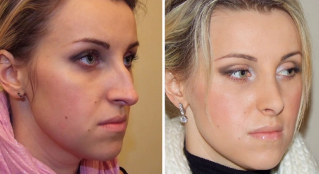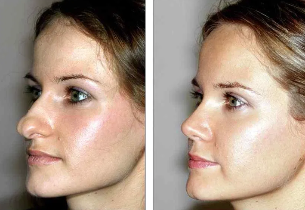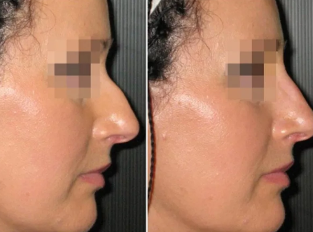Rhinoplasty is one of the most popular plastic surgery operations, which involves the manipulation in the field of the nose. The objective of this procedure is the correct recovery of the shape of the nose, which has broken down as a result of injury, diseases or congenital malformations, pathologies.
The development of the story

Maybe you believe that rhinoplasty is the recent invention, and have recourse to the services of the surgeons entirely some stars and models. No, it is not so. The first mentions about the technique of recovery of the nose relate to the old. These operations were carried out in india for 1000 years. c. the Indian doctors to repair damaged noses, taking the skin of the cheek of the patient.
In europe, the rhinoplasty has been developed in the Middle ages. Italian surgeons described a method to reconstruct the shape of the nose from the skin of the face. In the 19th century, this type of operations has received a new impetus, thanks to the efforts of English and German doctors. Have appeared new techniques, based on the experience of indian surgeons.
Initially, the appointment of the rhinoplasty was to rehabilitation of the nose, beauty treatments and aesthetic factors have acquired a value as at the end of the 20th century.
Testimonials from doctors to rhinoplasty
Any type of surgery can be called the creative process, and rhinoplasty is no exception. It combines the decision of aesthetic problems with the restoration or the maintenance of the functions of the authority (the normal nose breathing).
Therefore, this surgical intervention can pursue therapeutic and aesthetic objectives. It is best to do the operation age of 25 to 30 years, when the cartilage is fully formed. Of course, the recommended age may vary, depending on the individual circumstances.
Medical indications:
- The rape of the nose of the breathing or of the whole of your absence.
- Traumatic injury led to changes and deformation of cartilage and bones.
- Physiological and compensatory deviation of the septum.
- Innate curvature or deformation of the septum usefulness.
- Cysts and polyps in the nose.
- The hypertrophy of the nostrils of the sinks.
The breach in the anatomical structure of the nose, causing a functional complications pathological states. This can be: otitis media, rhinosinusitis, bronchial asthma, snoring, frequent respiratory diseases, atrophy or hypertrophy of the membranes of the nose, obstruction of the breathing usefulness.
It is especially dangerous violation of nose breathing for the children. May cause hypoxia of the brain, which leads to a physical and mental delay in development. The operation of recovery of the respiratory function can be assigned to 18 years.
Indications aesthetic rhinoplasty
More than half of the operations change the shape of the nose are performed for aesthetic reasons. Patients want to achieve harmony in your appearance. Aesthetic indications for the realization of the plastic surgery can be divided into two subgroups:
- Objective. When the nose has a disproportionate burden, the size, the shape.
- Subjective. This subset is referred to, first of all, the psychological causes, related to the evaluation of their own appearance. For example, the patient does not like a small hump or up.
Psychological causes are often related to vocational training or social. The patient appear complex, acute dissatisfaction with their appearance.
Aesthetic indications:
- Deviation of the septum.
- Acquired and congenital deformation.
- Disproportionate dimensions with respect to the face, when the nose appears too large or too small.
- Saddle the shape of the nose.
- Hump.
- Too wide nostrils.
- Unattractive way, when the tip of the nose is bifurcated, ignored, raised, thickened or sharp.
- Asymmetrical nose.
- Review of the consequences of a failure of the rhinoplasty.
It is important to understand that the result of the operation can not always get a perfect result. In the surgery, there are restrictions, therefore, the rhinoplasty must be understood as the correction of an existing form.
Contraindications

Before the surgery, many patients it is recommended to visit a psychologist. There are cases in which the patient has the normal shape of the nose without cosmetic or functional violations. Then the problem will be resolved after working with the psychologist.
Plastic surgeon can produce a special measurements, and say if there are any defects. There are certain parameters that are estimated as the shape of the nose, and the harmony of its provisions on the forehead, the eyes, the mouth, the chin, the ears. In the consultation of a doctor, you can simulate in the computer the alleged appearance after the operation.
Contraindications:
- The limit of age. The operation is not recommended before the age of 18 and after the age of 40. These limitations may be removed due to objective reasons.
- Diabetes, kidney disease, liver, cardiovascular system.
- Folliculitis and acne in the nose area.
- Clotting of the blood.
- Oncology.
- The mental illnesses.
- The period of menstruation.
Types of rhinoplasty
In function of the established objectives, and the technical execution of the surgery, rhinoplasty is divided into several types.
On the goal of the rhinoplasty may be:
- Reconstructive. It is the reparation of the violations which have occurred due to diseases, injuries, defects of the development by fetal.
- Of the aesthetic. Is the correction of cosmetic defects.
During the operation can be carried out:
- Increase or decrease of the nose.
- The removal of the hump.
- Correction of sedlovidnoy the shapes of the nose, that is to say, the solution of the deepening.
- The review of the shape of the tip of the nose.
- Septoplastike (is the correction of the septum and usefulness).
- Post-traumatic reconstruction.
On the methodology of access of the surgical intervention can be opened and closed. Closed the method is applied when the aesthetics of the operations, as it is less traumatic. In this case, all incisions are performed inside the cavity of the nose. The skin is separated from cartilage and the surgeon can easily correct the way you work with the bone and the cartilage, clean up the excess, or strengthen with the help of implants. After the manipulation of the courts are filed with care.
Open rhinoplasty is applied in complex cases, to the review of the major changes and the implementation of large volume of operations. The incision is made in the cutaneous fold between the wings of the nose. In this case, the surgeon receives a good access to the tissues, the cartilage and the bones. The healing of this method, it takes longer, it is still remarkable that the post-operative scar.
Non-surgical rhinoplasty
Non-surgical rhinoplasty is not an alternative intervention. However, there are methods to correct small imperfections.
Rhinoplasty with detectives special: cosmetic gels) will help to correct small defects, smooth out sharp angles, restoring symmetry, the change of the shape of the tip. The application of fillers allows you to mask a small bump, remove sinking, rounded at the tip.
The recovery period after the intervention, the easier, the price of a procedure is low in comparison with full operation. However, the effect of fillers will be maintained only during some months (maximum 1.5 year). In some cases, at the site of injection is fibrous form of the fabric and the effect of the procedure is maintained in the coming years. But more often it is necessary to return to the routine. There is the possibility of complications: the migration introduced the gel and the modification of the structure of the tissue from multiple injections.
Through injection can not only grow, but also to remove from the fabric. There are medications on the basis of hormone, which can eliminate the inequities, the bulge and even, in some cases, hump. In the introduction of these drugs is very important to be careful. Often the treatment is done in several stages. Through 2-3 weeks it will be remarkable results.
With the help of the threads, you can adjust the shape of the wings of the nose, and even pull up the tip. Set thread through the holes, in the place of those which can form scars. Thread may break due to the mobility of the nose. For these reasons, surgeons rarely resort to this procedure.

Preparation for surgery
For the success of the operation, it is necessary that the interaction of the patient and the doctor. Before the intervention is carried out is consultation, where the surgeon will explain to the patient that he will be to achieve the desired result.
Are made are general studies: analysis of blood, a study of the coagulation, urine analysis, ecg, hiv test, hepatitis, syphilis.
If necessary, are performed on special studies, the picture is taken. If there is a chronic disease, you need the advice of a therapist or profile of the specialist. The intervention is delayed in the case of the exacerbation of chronic diseases, the emergence of respiratory diseases acute infectious or lesions of the skin. Before the operation, there will be a talk with the anesthesiologist.
Your doctor may recommend to stop drinking alcohol, smoking, exclude heavy foods, stop taking hypnotics and sedatives. Two weeks before surgery should stop taking aspirin and its analogues.
Complications
Plastic of the nose is one of the most complex operations of plastic surgery, as well as the importance and the aesthetic and functional part. Complications in function of various factors, the 4-15% of patients. Can be divided in operative and postoperative.
Operating complications:
- bleeding;
- cuts in the skin;
- the violation of the integrity or fractures of the bones;
- the separation of the cartilage flap, etc
Postoperative complications:
- loss of sense of smell;
- the loss or decrease of the sensitivity of the nose and the lower lip;
- the obstruction of the nose, of the breath;
- atrophic rhinitis;
- the deterioration of the correct cosmetic for the lack or the absence of changes;
- psychological complications (the patient does not take the changes in the appearance, you don't like the new face);
- the inflammation of the nose and the eyelids, swelling, pus;
- the pigmentation of the skin, formation of scars, the capillary action of the mesh;
- frequent or prolonged, bleeding usefulness;
- necrosis.
It is the most dangerous complication that can arise during the rhinoplasty is an allergic reaction to the anesthesia. Anaphylaxis can lead to death in 20% of cases.
The recovery period
The patient can leave the clinic a few hours after the operation, or to spend the night for observation. Main recovery after the correction of the nose has a duration of 3 weeks. The full recovery of so it will only come through six to twelve months.
The seams and plaster Longuet, removed over 1.5 weeks. Still 2 weeks you can't take a hot bath, wash the hot water – this can cause bleeding, hematoma, swelling of the face and neck. Sleep is necessary in the back to be reclined. You can't bend, lift weights. In dusty you need to use a facial mask.
In the period of three months is necessary carefully to stay safe from shocks and pressure on the nose, you can't wear the glasses, masks, heavy hats. It is forbidden to make use of the pool and take the sun. The surgeon may establish such other limitations imposed on an individual patient's condition.
The results of the operation
The healing of cartilage and bone, that lasts for several months. The end result of a surgeon and the patient can be estimated in approximately 8 months. The decision to do rhinoplasty (especially if you don't have very clear directions) can be viewed by others negatively, so that the patient must be willing to the ambiguous reaction on the part of family and friends.
The family may be dissatisfied with the loss of family members or ethnic devil. However, the frequency and the patient himself and his family, do not notice a special effect of that operation, as well as swelling of the hide changes, and to manifest it little by little.
Rhinoplasty is capable of doing much to change my appearance, but it is not worth to believe, that with the help of plastic surgery can be, without the limitations of the model all represented in the fantasies. The whole operation is a dangerous thing, can lead to complications and even to a deterioration of the stain. Therefore, to refer to such intervention should be seriously, weighing carefully the potential benefits and risks of negative effects.




















